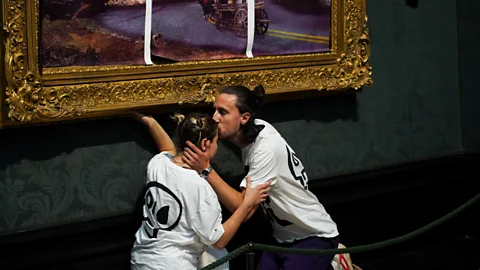The first time Sarah Corbett picked up a cross-stitch she was on a train to Glasgow, Scotland. Her hands were shaking and her breath was shallow. As she worked out how to do cross-stitch, she became increasingly aware of how stressed she was. The cross-stitch, which requires careful attention and slow, repetitive movements, made her realise she was feeling completely burnt out.
It was 2008 and Corbett, a lifelong activist, had spent her career so far working for charities such as Christian Aid and Oxfam on their campaigns.
In her spare time, she also attended activist groups campaigning for social and environmental causes, but she didn’t feel like she fitted in with some of those groups. “I didn’t like the abuse they were doing, or using activism as an excuse to be unkind and scream at people and do illegal things,” she says.
As an introvert who dislikes confrontation, Corbett’s activism had been taking a toll on her mental health. As she worked on her cross-stitch on the train and reflected on how she was feeling, the passengers next to her asked what she was doing.
Corbett was stitching a picture of a bear, and saw this as a missed opportunity. “I thought, if only I was stitching a quote by Gandhi, we could talk about inequality,” she laughs. “Because my obsession is activism and social change, not craft.”
She realised crafts could be a useful tool for starting conversations. This was her starting point for “gentle protest”, a form of activism built on a slow, thoughtful approach rooted in empathy and contemplation.
Not long after her train journey, Corbett began researching craft and activism and soon came across the work of Betsy Greer, a knitter and anti-sweatshop activist, who had coined the term “craftivism” in 2003. Since then, craftivism has been taken in different directions by grassroots groups around the world, from straightforward awareness-raising, to punk-inspired “yarn bombing” public spaces by covering trees, lampposts and postboxes with knitted “graffiti”.
Corbett became interested in the nonconfrontational, quiet, reflective nature of craft and began developing the idea of “gentle protest”. Her approach focuses on a slow, contemplative kind of activism. “Use the slow, stitch-by-stitch nature of craft to help you consider the complexities of injustices. It will lead to a deeper understanding of them and their solutions,” reads one point of her “craftivist manifesto”.
Today, the walls of Corbett’s flat in south London are lined with drawers, cupboards and suitcases of craft materials, examples of small gifts people have made embroidered with environmental slogans, and other social justice causes, such as LGBTQ rights and anti-racism. In one drawer, a small white cotton cloud reads “I dream of a healthy planet”. A box of labels to sew into clothes contains messages such as “Good intentions are just the start”.
Corbett’s approach is a world away from the noisy world of placards, marches and civil disobedience that prominent groups, such as Extinction Rebellion and Just Stop Oil, make headlines for.
“I think that’s what makes it so powerful,” says Lynn Sanders-Bustle, associate professor of art education at the University of Georgia, who has researched craftivism and the experiences of its participants. She believes the potential of craftivism comes down to three main elements.
First, Sanders-Bustle says the reflective nature of craftivism can lead to new perspectives. “In some of the sessions that [Corbett] implements, they gather this collective of people, and intentionally they pose questions that are related to the topic. So in other words, it’s not enough to go out and protest climate. You’re going to move the needle on your own learning and your own understanding of the issues,” she says.
Second, there’s the fact that these activities, though they can be solitary, are often done in a group. “You’re bringing people together, and you are working on a project together,” says Sanders-Bustle. “We are hearing more and more about the need for community and the need for social interaction. And there’s almost a meditative component to it, right? You’re sitting there, you’re working, you’re gluing, you’re knitting, you’re yarning. That’s where there’s potential for people to relax, reflect, be open to others’ ideas,” she says.
And the final piece, says Sanders, “is that it’s a creative project. And in my mind, it’s through a creative project that new solutions are generated, whether it’s climate or anything else. It’s through imagination,” she says.
It might seem counterintuitive that a form of protest that can be solitary, reflective and thoughtful has reached so many. For a quiet form of protest, its ripples are spreading far and wide.











No comments yet. Be the first to comment!